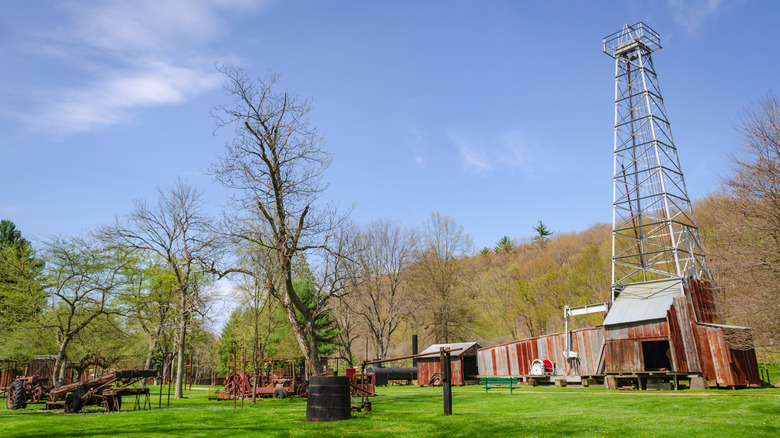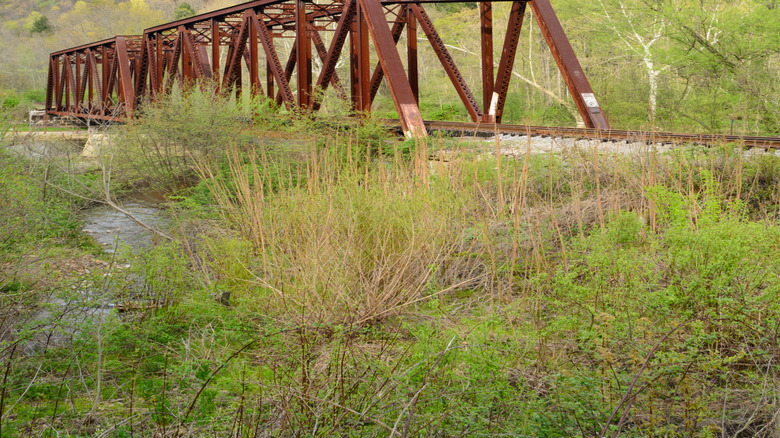
The sounds of rushing waterfalls and the Oil Creek and Titusville train clanking on the tracks reverberate across the vestige of old houses, echoing down abandoned oil wells while the old equipment rusts. As the forest and vegetation reclaimed the land, it's difficult to imagine the valley of Oil Creek once teeming with ambitious people pining for liquid gold.
However, Oil Creek State Park in Northwest Pennsylvania had a significant place in history. This is where the words "They've struck oil!" were
first shouted in 1859, and it's the birthplace of the world's first commercial oil well. Now, only shadows of the past remain, waiting for explorers to observe the story they have to share. This historic significance places it up there with Centralia, a once-thriving quintessential mining destination in Pennsylvania. About 6,800 acres in size, the park is lined with 52 miles worth of trails that snake past these once-lively settlements. It's located 2 hours north of Pittsburgh and 2-and-a-half hours east of Cleveland.
One of the best ways to enjoy this park is to camp. There are two hike-in areas available for camping: Cow Run and Wolfkiel Run shelters. Per Reddit users, these are more areas than they are sites, capable of housing many tents. There are no marked areas for setting up camp, so visitors are free to pick a spot that works for them. The backpacking permit is $5 a night per person in their group, increasing to a flat $21 per night between Memorial Day and Labor Day. Large groups of up to 25 people can book an organized group tent site at Wildcat Hollow or McCrea Farm for $43 a night. All prices listed are at the time of this writing.
Read more: The 5 Best Parks Where You Can See Bison Roam (Other Than Yellowstone), According To Visitors
Hit The Trails Through Ghost Towns

The 36-mile Gerard Hiking Trail serves as the main route. Five shorter paths loop and connect together within the Gerard Hiking Trail. They offer the opportunity to spot the abandoned oil wells dotting the valley, along with old equipment and former shelters. A good place to start is the Blood Farm Interpretative Trail. The half-mile loop guides you through the Blood family's oil-leased land. Wooden structures still stand between the trees, and oil wells with their designated numbers and depths marked on their lids can be peeped beneath the green.
At some point, the trail traces the creek, and you might be able to spot the Rynd Farm Train Station across the water. Next to the train station is the landmark Coal Oil Johnny House, an old home built in 1850 by the McClintock family. The house can be visited during open houses throughout the year. Otherwise, visitors can look inside the house through the windows.
For a look at a true ghost town, hit up the Petroleum Centre Walking Tour. Another short hike at a half-mile out-and-back, it cuts through the Petroleum Centre, once called "wickedest town east of the Mississippi," that once thrived from 1863 to 1870. It had the vibes of a Wild West town, with no government, laws, or public services. The visitor's center at the old train station in Petroleum Center features dioramas that encapsulate the one booming town. It is open during the summer from 11 a.m. to 5 p.m. on Saturday and Sunday.
Once you wrap up your stay at this state park, hit up the underrated Tuscarora State Park, which offers lakeside trails and quiet cabins, or the free-to-visit Erie Bluffs State Park filled with scenic trails and views.
Ready to discover more hidden gems and expert travel tips? Subscribe to our free newsletter for access to the world's best-kept travel secrets.
Read the original article on Islands.













